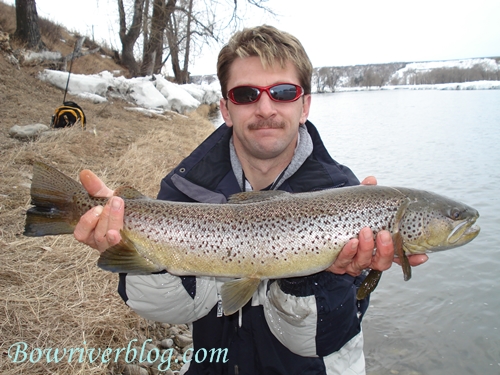BROWN TROUT INFORMATION
Brown trout are a territorial species that prefer staking out a protected homeland near the edges of fast currents and back pools off current edges. Any obstruction in the water that may provide cover for the light-sensitive fish is a good area to cast. Fish for browns in the same waters as described for Rainbow and Brook trout, but remember that the warm water/low-oxygen tolerant browns may be overlooked by anglers that bypass the slow, deep pools in the river. As like the largemouth Bass, cast for big Browns near rock piles, brush mounds, edges of the river where grass is overhanging the water, and submerged logs. The larger predatory browns are sometimes indiscriminate feeders, known here to eat water snakes, ten-inch Rainbow Trout, big Rocky Mountain White Fish, young muskrats, and even their own kind.
This hardy fish can tolerate water temperatures from five to more than ten degrees warmer than can other trout species, as well as inhabit semi-polluted waters and rivers with lower-than-average oxygen levels. This is why many believe this species of trout are the trout of the future. Brown trout are territorial, and seasoned anglers use this knowledge when they find a seemingly empty region of a river. The veteran will not bypass the barren stretch, anglers should assume that this stretch of water is the territory of a large brown trout that has successfully defended its homeland, this so called baron stretch, and eaten smaller intruders. It has now moved in.
The Brown Trout, which is Light sensitive, feed under shade-providing brush piles and at dusk, and well into darkness. The obstruction-filled waters inhabited by Brown Trout hamper most attempts at presenting any lures, baits, or flies to the protected fish. In open water, too, the fish has a tendency to swim directly for underwater cover, such as large boulders or large weed beds, and grasp these submerged objects until finally opening its mouth to breathe.
Unlike Brook and Rainbow trout, Brown trout prefer natural-looking baits and have impressive faculties of vision, smell, and hearing, able to focus on two objects placed at different distances at once in dim, cloudy waters. These baits include grubs made of plastic, browns or black in color, baitfish that resemble Rainbow Trout, Brown Trout, or any kind of sucker minnow that is swimming in your river, stream or lake.
Like other species of trout, Browns spawn in gravel nests dug on the river bottom or over shore gravel bars in lake waters between seven and fifteen feet deep. The Browns spawn from September to December, as dictated by the climate and water conditions. Predatory minnows and crawfish eat a large portion – around 95 per cent – of the eggs and hatched fry. In three to five weeks, the vulnerable fry hatch from the surviving eggs. This can make for ideal fishing conditions as other fish like Rainbows or Brook Trout will come in to feed off the fry of the spawning Browns. This can also work in your favor to hook into the larger Browns, as they will strike these fish that come in to feed on their eggs or fry.

